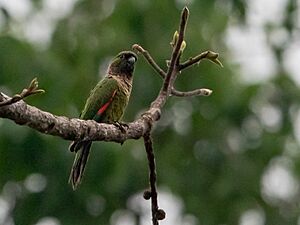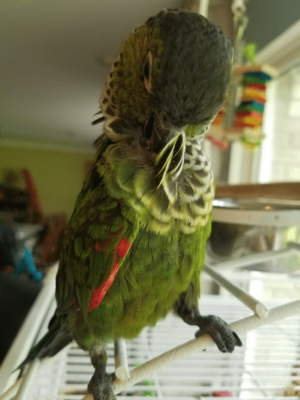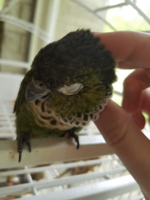Black-capped parakeet facts for kids
Quick facts for kids Black-capped parakeet |
|
|---|---|
 |
|
| Conservation status | |
| Scientific classification | |
 |
Meet the Black-capped Parakeet (Pyrrhura rupicola)! This amazing bird, also called the Black-capped Conure, is a type of parrot. It lives in the south-western Amazon Basin and the eastern Andean mountains. You can find them in countries like Peru, Bolivia, and Brazil.
These parakeets are about 25 cm long, which is roughly the size of a ruler. Most of their body is green. They have cool off-white patterns on their neck and chest. They also have some red feathers under their wings.
Black-capped Parakeets live in humid forests. They can be found from the lowlands of the Amazon up to 1000 meters high in the mountains. Even with some deforestation in the Amazon, they are currently listed as a species of "Least Concern." This means they are not in immediate danger.
These birds are very social. They often fly in groups of up to 30 birds. During breeding season, they form smaller family groups. In aviculture (which means keeping and breeding birds), these parakeets can have babies. They can even mate with Green-cheeked Parakeets. This creates a mix of the two types.
Contents
About the Black-capped Parakeet
The Black-capped Parakeet was first described in 1844. This was done by a Swiss scientist named Johann Jakob von Tschudi.
There are two main types, or subspecies, of Pyrrhura rupicola:
- P. r. rupicola
- P. r. sandiae
The P. r. rupicola type lives in western South America. It is very common in Peru. The P. r. sandiae type is found in western Brazil, south-east Peru, and northern Bolivia. This type is sometimes called the Sandia Conure. It has thinner patterns on its neck and chest. It also does not have patterns on the back of its neck.
Sometimes, Black-capped Parakeets can breed with Green-cheeked Parakeets in the wild. The official name "Black-capped Parakeet" was given by the International Ornithologists' Union. In the pet world, they are often called Black-capped Conures or Rock Conures.
Black-capped Parakeet Behavior
Black-capped Parakeets are very social birds. They like to roost (sleep) together in groups. In the wild, they live in flocks of up to 30 birds. During the time they have babies, smaller family groups form. These parakeets also really enjoy bathing!
In their natural home, Black-capped Parakeets eat food from the tops of trees. They can live up to 30 years when cared for by humans.
Breeding Habits
Black-capped Parakeets are ready to have babies when they are between 1 and 3 years old. During breeding season, they roost in small groups. A female usually lays 4 to 7 eggs. The eggs hatch after about 24 days. The parents then take care of the babies for 7 to 8 weeks. Their breeding season is usually from February to March.
What They Eat
Wild Black-capped Parakeets eat many different things. Their diet includes fruits, nuts, berries, and other plants. Sometimes, they might even eat crops from farms.
Protecting Them
Black-capped Parakeets are listed as "near-threatened" in the wild. This means they could be at risk in the future. The main reason for this is deforestation in the Amazon. This is when forests are cut down. It is estimated that a lot of their natural home could be lost over time. Losing forest areas near streams and other issues make this problem worse.
Black-capped Parakeets as Pets
In the pet world, Black-capped Parakeets are known as Black-capped Conures. They are often called the quietest of the conure types. But, if they get bored or are left alone too long, they can be loud! They are most active in the morning and evening.
These birds are very social and need a lot of attention. They might be a bit shy around new people at first. But their curious nature often helps them get over their shyness quickly. To stay clean and keep their feathers neat, they preen themselves. This means they smooth their feathers with their beaks. After preening, they might yawn to clear their noses. Conures often love to have their heads gently scratched by their owners. They might show this by bowing their heads or rubbing against a hand.
Pet Behavior
Black-capped Conures are very curious birds. They need many different toys to keep them busy. It's a good idea to have lots of toys and switch them out every few days. Toys like bird puzzles can keep them entertained and prevent boredom.
These conures love water! They enjoy bathing and even dipping their dry food in water. Because of this, their water bowl should be changed at least twice a day. After bathing, Black-capped Conures shiver. This helps them build and keep their body heat.
What to Feed Your Pet Conure
A Black-capped Conure should eat a healthy mix of fruits, vegetables, and special bird pellets. The pellets should make up about 75% of their food. The other 25% should be fresh fruits and vegetables. Seeds, nuts, and other fatty treats should only be given as rewards or small additions to their diet.
Give your conure a wide variety of colorful fruits and vegetables. Light green or white vegetables usually don't have much nutrition. Conures can eat some human foods. But they must never eat avocados, chocolate, alcohol, or caffeine. They can have small amounts of meat and eggs. However, they should avoid foods high in fat and salt.
Why Birds Might Bite
Wild conures do not bite often. Birds have their own ways of communicating that humans sometimes don't understand. This can lead to a bite. Conures might also bite to get a strong reaction from their owners. If putting the conure in its cage is the response to biting, they might start biting when they want to go back to their cage. Or, they might start to dislike their cage.
The best ways to handle unwanted biting are to firmly say "no" or to ignore the bird and leave the room.
Feather Plucking
Sometimes, a Black-capped Conure might start pulling out its own feathers. This can happen if they are bored. This is a harmful habit that needs to be stopped quickly. To help stop plucking, add new or different interactive toys to their cage. Also, increase the amount of time the bird spends outside its cage.
Breeding Pet Conures
Black-capped Conures can be bred by humans. They usually start breeding around 18 months old. This age can be different for each bird. Female birds should be put into the nesting cage first. This gives them time to get used to the new space before the male is added. It's best to pair them up at the end of December. There are usually no problems with the birds accepting each other.
Eggs are laid in February. They hatch about 23 days later in March. It's best to leave the nest boxes alone. Only check them if the parents are not taking care of their young. You can tell if babies are being fed by listening to their cries. If their cries are strong and then stop, it means they are being fed. The baby birds are ready to leave their parents when they are about eight or nine weeks old.







